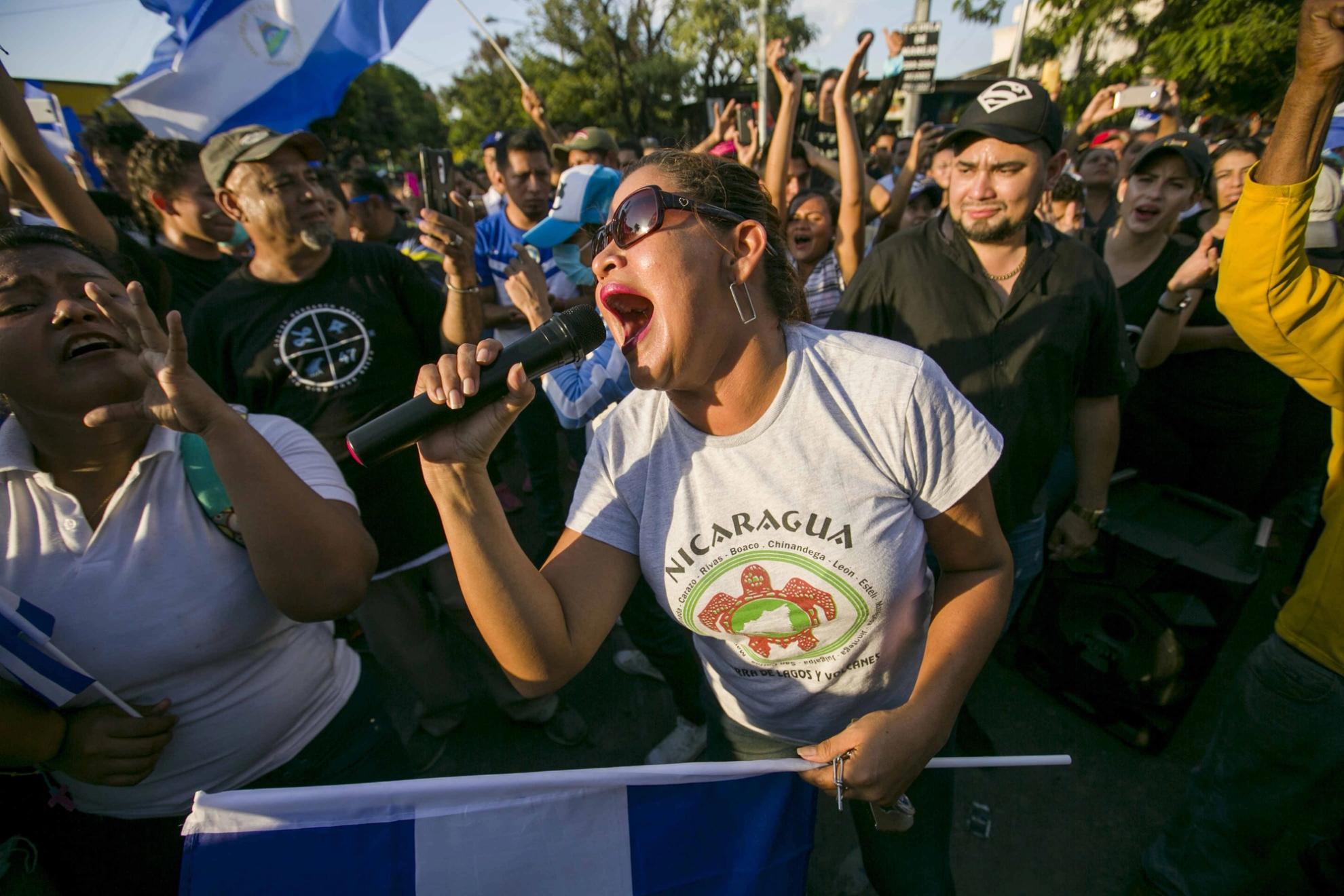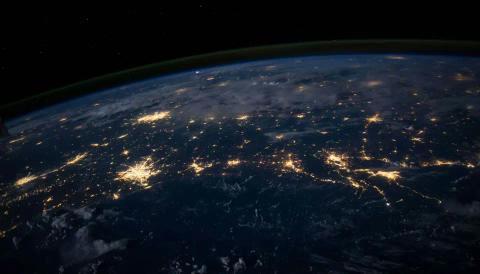Nyhet
A hot week in Managua

I arrived in warm, sunny Managua on the Monday evening of the 16th of April. The first thing I heard when I turned on the TV at the hotel was the news about the newly approved social security reform. Implemented by decree, without public consultation, the package included tax raises for employers, employees and retired people. Tired from the 24-hour flight from Oslo, I registered and crashed in the hotel bed.
Day one: JS in action
The following day, I heard that there had been a small protest of students and elders against the new pension tax, and that they had been beaten up by Juventud Sandinista (JS), the militia-like hardline group supported by Ortega and specialized in “keeping the peace” by dissolving popular demonstrations against the government, no matter how. Someone from JS had beaten up an old man here, another had stolen a camera from a journalist there, while the police watched.
The JS were everywhere, camping in Managua's wide roundabouts, by the 20-meter tall colorful metal trees – the so called “trees of life”, a symbol of the Ortega government. They were under tents with chairs, water bottles and a sound system; some were partying and dancing. I learned that they were waiting for the people to protest against compañero Ortega later in the day. Their job was to stop them. And they did their job, I heard later.
Day two: Sandinism is not Orteguism
On Wednesday, I felt tension in the air. During lunch, I heard again that there had been clashes near the Metrocentro roundabout, where two universities are located. Rubber bullets, tear gas, mortars. Some of them were trapped inside the university campus and surrounded by armed police. Sitting in the Managua traffic, I was constantly updated by Whatsapp on the situation and the subtleties of the Ortega regime in manipulating politics, elections and propaganda. I heard older stories from the time of the revolution, and how the Ortega regime had hijacked the narrative of Sandinism and distorted what was once its original spirit. “Sandinism is not Orteguism” – that is what people in the streets were trying to say.
By the end of the day, back in the hotel, news came that the first students had been killed in the clash, and that other universities were joining the demonstrations. I couldn't help thinking how bizarre it felt to be lying in bed in a hotel, while somewhere else in the city, not far away, there was a war going on. A war of police against students.
Day three: Glowing hot
After a breathtaking excursion to the Masaya volcano, we decided to return to Managua sooner due to the rumors that people were marching to Masaya and clashes were expected. I looked around. Stores and restaurants were closed, the main avenue and roundabouts were occupied by the JS. It's probably true, we'd better get moving. We ate a lovely Baho at Vilma’s, the brave last open restaurant in Masaya that day, and headed back to Managua, in a blazing hot afternoon.
Back in Managua, at the university campuses, students were throwing rocks amid burning tires and using car hoods as shields against the police attacks. At one university, students were still trapped inside the campus; as the night came, the police cut the power and waited outside, with live ammunition. Water, food and medical assistance to people were blocked. Medicine students were giving emergency help and taking care of people cut, beaten, shot or intoxicated. People began to set fire and tear down the “trees of life”.
Back at the hotel, I sat by the pool and chatted with the bartender, a hardcore Sandinista (but not Orteguista!). The news from his loud Whatsapp gave me a feeling of experiencing parallel worlds. I checked Twitter to see that some were complaining that #Avicii (the 28-year old Swedish artist who had just died) was trending more than #SOSNicaragua. Five students had been killed in the third day of the clashes. Masaya, where I had been just about 6 hours ago, had become a battlefield. In Monimbó, a bastion of Sandinism, people were also taking the streets against Ortega for vilifying the heritage of Sandino with corruption and social injustice.
There was nothing about the clashes in international media, nothing in Norway. The TV by the pool bar showed football. TV channels that had independently covered the protests live had been shut down without prior notice. The few news brought by Orteguist TV channels were blaming a small right-wing group of “vandals” for breaking the peace in the country. It wasn't quite convincing.
UNEN, the Nicaraguan National Student Union, controlled by Ortega’s government, was calling for peace and support to the government. Back in the 1990s, the student organization had, hand-in-hand with the Sandinist Party FSLN, played a key role in political demonstrations for the approval of the legislation ensuring a permanent 6% allocation of the public budget to higher education. Now, UNEN was supporting the social security reform as a gesture of social justice; those that were against it were only “thinking about themselves”.
According to Nicaraguan law, UNEN is the only university student organization allowed in the country. The election of their representatives in public universities has always been politically conflictive, with a clear dominance of JS, backed by the government. Now, it looked like UNEN had lost its grip in mobilizing students. Most of the students resisting on the streets were not affiliated to any particular guild or association. The only circumstance that bound them together was the resistance against the Ortega government. The FSLN flag had long ceased to represent them. The following day, I was told that UNEN leaders were threatening affiliated students that were not willing to participate in demonstrations in support of the government.
At some point, I started hearing the sound of fireworks, smelling gunpowder, and watching the smoke drifting into the pool area of the hotel, where all the gringos were having their drinks, including me. It was around 8:30 PM and the students at UPOLI, the Polytechnic University, located some hundred meters from the hotel, were still fighting the police.
My meetings for the next day were rescheduled from afternoon to morning. Protests usually started around 10 and escalated until after midnight – for the past 3 days already. Between 3 and 9 o'clock in the morning, Managua was cooler, the risk was lower. “It gets more caliente from the afternoon on”, someone told me.
Day four: The Battle of the Cathedral
On Friday, I was alerted that it would be a good idea to change hotels, and move somewhere nearer the airport. I was taking the plane back to Oslo the following day, 21st of April.
On that Friday afternoon, the main battleground became the Managua Cathedral, where students were fleeing in search of protection and support (water, food and medical care). People from JS and the police were throwing bombs in the Cathedral and threatening to invade it. One of the bishops in Managua urged the government to stop repression, and declared his support to the students and their fight for social justice. At that point, it was not only about the social security anymore; it was about everything else: freedom of expression, corruption, inequality, poverty, bad education and health systems.
In Jinotega, Granada, Leon and other places, people were burning down public buildings and radio stations. The protests had escalated to national level. It was not just a few “right-wing vandals”, it was the largest civic mobilization in the last ten years, maybe more, according to some. And the students were leading it, at the cost of their lives. I could hear the bombs and see the smoke rising from the UPOLI campus from my hotel window. I checked with the hotel crew, and they guaranteed there was no problem in reaching the airport. I was leaving the hotel at 5 AM, during the intermezzo.
Days five/six: students are the “moral reserve” of the country
As I checked out early morning, the lady in the reception gave me a copy of the day's newspaper: it counted seven deaths. Some hours later, during my stopover in USA, I checked Twitter again: ten deaths. It was Saturday, and news were spreading around the world: The United Nations and even Pope Francis were urging the government to stop repressing the students. News had reached BBC, CNN, The Guardian, The New York Times, thanks to social media.
In the streets of Managua, supermarkets were being looted, and a crowd of parents were demanding to see their children, many under legal age, who had been taken to prison without any information. Around 200 people were still detained, and 60 people were still disappeared, according to the local media.
I took the long flight to Amsterdam, and when I checked Twitter again, on Sunday morning, there were 28 deaths. A journalist from Bluefields had been shot during a live Facebook streaming. The brave bishop of Managua, Silvio José Báez, declared the students the “moral reserve” of the country for their struggle for social justice and called for the government to stop repression. Daniel Ortega made his first public appearance on Saturday, and declared that the social security reform was cancelled, and that he would engage in dialogue. Students were making history happen.
Back in my office in Oslo, I try to keep pace of what’s going on in Managua. After a huge peaceful demonstration on Monday, called by private sector representatives, the Nicaraguan Catholic Bishop’s Conference accepted to mediate a dialogue between the government and the students that participated in the riots. The students call themselves now Movimiento 19 de Abril, and they want democracy and freedom of speech back. They are willing to participate in the dialogue as long as the safety of students and people is ensured, and no political persecution takes place against participants.
Day before yesterday (Wednesday 25/4) there was another massive demonstration to mourn the dead – now counting 38. Most of the students that were detained by the police were released, but under terrible conditions and after being tortured in prison. Human rights organizations are following up their cases. There are still people disappeared.
It is not clear how this dialogue process is going to develop. On the one side, Ortega is open for dialogue, but not to renounce. On the other side, the situation on the streets is still unstable, there are still quite a few loose ends. People want more freedom, they want to be able to vote in whoever they feel like without JS harassing them all the time. People expect also redress for the losses suffered and punishment for those responsible. If they feel this dialogue is just a maneuver from Ortega to hang in to power, violent conflicts can resume.
Whatever the outcome, one thing is certain, as Matagalpa bishop Rolando Álvarez said: “the university students are revealing to be the real heroes of truth in Nicaragua”.







